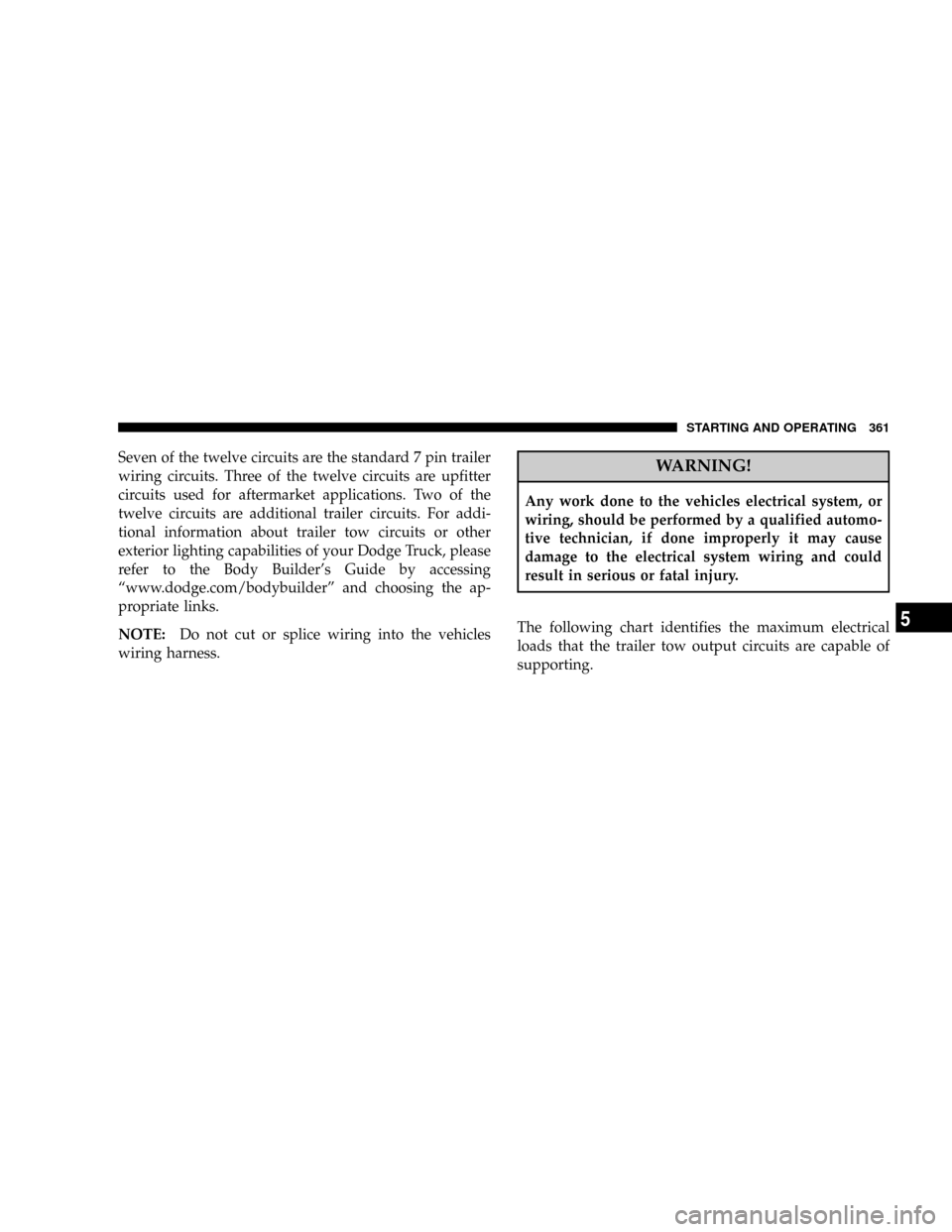2008 DODGE RAM 3500 CHASSIS CAB wiring
[x] Cancel search: wiringPage 50 of 528

²The driver and front passenger seats should be moved
back as far as practical to allow the airbag room to
inflate.
WARNING!
²Relying on the airbags alone could lead to more
severe injuries in a collision. The airbags work
with your seat belt to restrain you properly. In
some collisions the airbags won't deploy at all.
Always wear your seat belts even though you have
airbags.
²Being too close to the steering wheel or instrument
panel during airbag deployment could cause seri-
ous injury. Airbags need room to inflate. Sit back,
comfortably extending your arms to reach the
steering wheel or instrument panel.Airbag System Components
The airbag system consists of the following:
²Airbag Control Module
²AIRBAG Readiness Light
²Driver Airbag
²Passenger Airbag (If Equipped)
²Steering Wheel and Column
²Instrument Panel
²Crash Sensor
²Interconnecting Wiring
²Knee Impact Bolsters
²Passenger Side Frontal Airbag ON/OFF Switch (Stan-
dard Cab Vehicles Only ) (If Equipped)
50 THINGS TO KNOW BEFORE STARTING YOUR VEHICLE
Page 56 of 528

Maintaining Your Airbag Systems
WARNING!
²Modifications to any part of the airbag system
could cause it to fail when you need it. You could be
injured because the airbags are not there to protect
you. Do not modify the components or wiring,
including adding any kind of badges or stickers to
the steering wheel hub trim cover or the upper right
side of the instrument panel. Do not modify the
front bumper, vehicle body structure, or frame.
²You need proper knee impact protection in a colli-
sion. Do not mount or locate any aftermarket equip-
ment on or behind the knee bolster.
²It is dangerous to try to repair any part of the airbag
system yourself. Be sure to tell anyone who works
on your vehicle that it has airbags.
NOTE:Perchlorate Material ± special handling may
apply, See www.dtsc.ca.gov/hazardouswaste/perchlorate
Airbag Light
You will want to have the airbags ready to
inflate for your protection in an impact. While
the airbag system is designed to be mainte-
nance free, if any of the following occurs, have
an authorized dealer service the system promptly:
²The airbag light does not come on or flickers during
the 6 to 8 seconds when the ignition switch is first
turned on.
²The light remains on or flickers after the 6 to 8 second
interval.
²The light flickers or comes on and remains on while
driving.
56 THINGS TO KNOW BEFORE STARTING YOUR VEHICLE
Page 126 of 528

beam. An indicator light located in the instrument cluster
will illuminate when the fog lights are on. The fog lights
will turn off when the switch is pushed a second time,
when the headlight switch is rotated to the OFF position,
or the high beam is selected.
Multifunction Control Lever
The multifunction control lever is located on the left side
of the steering column.
Turn Signals
Move the lever up or down to signal a right-hand or
left-hand turn.
The arrow on either side of the instrument cluster flashes
to indicate the direction of the turn, and proper operation
of the front and rear turn signal lights. If a defective bulb
or wiring circuit is detected for the turn signal system, the
arrow indicators will flash at a faster rate. If an indicator
fails to light when the lever is moved, it would suggest
that the switch or indicator lamp is defective.You can signal a lane change by moving the lever
partially up or down.
Turn Signal Auto-Mode
Tap the multi-function control lever once and the turn
signal (left or right) will flash 3 times, and automatically
turn off.
Turn Signal Lever
126 UNDERSTANDING THE FEATURES OF YOUR VEHICLE
Page 303 of 528

operation and return to ªstandard vehicle operationº
simply turn the up fitter provided on/off switch to the off
position or press the ªcancelº cruise switch.
To operate the PTO via a remote switch the customer
must make sure the above conditions are met. It is vital
for proper operation that the PTO and remote have been
installed correctly paying special attention to ensure the
vehicle provided wiring has been connected properly.
This is the responsibility of the installer of the PTO and
switches/remote system. It is the responsibility of the
PTO manufacturer to ensure that their electrical (switches
and remote) system is compatible with the vehicle's
electrical architecture and software functionality.
Mobile Mode
To operate the PTO in this mode the vehicle must meet
the following conditions:
²Dealer selected ªmobileº mode activated via Dealer
proprietary service tool
²Upfitter provider (on/off) switch has been activated
²Vehicle must be in ªparkº or ªdriveº position (vehicles
equipped with automatic transmission)
²Parking brake must not be applied
²No vehicle, brake or clutch switch faults present
²Vehicle must be running
²PTO must be correctly installed using the vehicle
provided circuits
The customer may choose to use the PTO while the
vehicle is moving. To do so the PTO function must be
activated prior to taking the vehicle out of ªparkº. This is
accomplished by activating the up fitter provided PTO
on/off switch. At this point the customer may place the
vehicle in a forward or reverse gear and have PTO
STARTING AND OPERATING 303
5
Page 304 of 528

operation. To disengage PTO operation and return to
ªstandard vehicle operationº simply turn the up fitter
provided on/off switch to the off position.
NOTE:For application specific information with respect
to PTO and pump requirements and additional vehicle
information (wiring schematics, preset idle values, en-
gine speed limits, and vehicle hardware and software
requirements) please refer to the Dodge Body Builders
Guide by accessingªwww.dodge.com/bodybuilderºand
choosing the appropriate links.
Power Take Off ± Aftermarket Installation
If you did not order the PTO (Power Take Off) Prep
Package from the factory and want to convert your
vehicle, refer to the Body Builders Guide at
www.dodge.com/bodybuilder or contact the manufac-
turer directly at [email protected] (e-mail), 866±205±
4102 (toll free) or 313±493±2020.
DRIVING ON SLIPPERY SURFACES
When driving on wet or slushy roads, it is possible for a
wedge of water to build up between the tire and road
surface. This is known as hydroplaning and may cause
partial or complete loss of vehicle control and stopping
ability. To reduce this possibility, the following precau-
tions should be observed:
1. Slow down during rainstorms or when roads are
slushy.
2. Slow down if road has standing water or puddles.
3. Replace tires when tread wear indicators first become
visible.
4. Keep tires properly inflated.
5. Maintain sufficient distance between your vehicle and
the car in front to avoid a collision in a sudden stop.
304 STARTING AND OPERATING
Page 360 of 528

þAn electronically actuated trailer brake controller is
required when towing a trailer with electronically
actuated brakes. When towing a trailer equipped with
a hydraulic surge actuated brake system, an electronic
brake controller is not required.
þTrailer brakes are recommended for trailers over 1,000
lbs (454 kg) and required for trailers in excess of 2,000
lbs (907 kg).
CAUTION!
If the trailer weighs more than 1,000 lbs (454 kg)
loaded, it should have its own brakes and they
should be of adequate capacity. Failure to do this
could lead to accelerated brake lining wear, higher
brake pedal effort, and longer stopping distances.
WARNING!
Do not connect trailer brakes to your vehicle's hy-
draulic brake lines. It can overload your brake sys-
tem and cause it to fail. You might not have brakes
when you need them and could have an accident.
Towing any trailer will increase your stopping dis-
tance. When towing you should allow for additional
space between your vehicle and the vehicle in front
of you. Failure to do so could result in an accident.
Towing Requirements Ð Trailer Lights & Wiring
Whenever you pull a trailer, regardless of the trailer size,
stop lights and turn signals on the trailer are required for
motoring safety.
Twelve trailer tow circuits are provided at the rear of the
chassis. These circuits are unterminated and sealed.
360 STARTING AND OPERATING
Page 361 of 528

Seven of the twelve circuits are the standard 7 pin trailer
wiring circuits. Three of the twelve circuits are upfitter
circuits used for aftermarket applications. Two of the
twelve circuits are additional trailer circuits. For addi-
tional information about trailer tow circuits or other
exterior lighting capabilities of your Dodge Truck, please
refer to the Body Builder's Guide by accessing
ªwww.dodge.com/bodybuilderº and choosing the ap-
propriate links.
NOTE:Do not cut or splice wiring into the vehicles
wiring harness.WARNING!
Any work done to the vehicles electrical system, or
wiring, should be performed by a qualified automo-
tive technician, if done improperly it may cause
damage to the electrical system wiring and could
result in serious or fatal injury.
The following chart identifies the maximum electrical
loads that the trailer tow output circuits are capable of
supporting.
STARTING AND OPERATING 361
5
Page 525 of 528

Changing............................ 380
Dual............................336,386
General Information.................... 322
High Speed.......................... 327
Inflation Pressures..................... 323
Jacking............................. 380
Life of Tires.......................... 331
Load Capacity.....................318,319
Quality Grading....................... 506
Radial.............................. 328
Replacement......................... 331
Rotation............................. 335
Safety...........................313,322
Sizes............................... 315
Snow Tires........................... 334
Spinning............................ 329
Steel Carcass Ply....................... 325
Tread Wear Indicators................... 330
Wheel Mounting....................... 380Wheel Nut Torque..................... 384
Tongue Weight/Trailer Weight.............. 356
Torque Converter Clutch................278,285
Tow Hooks, Emergency................... 394
Towing............................... 351
Disabled Vehicle....................... 395
Guide.............................. 356
Recreational.......................... 369
Weight.............................. 356
Traction.............................. 304
Traction Control......................... 445
Trailer Towing.......................... 351
Cooling System Tips.................... 363
Hitches............................. 355
Minimum Requirements................. 357
Mirrors...........................85,364
Trailer and Tongue Weight................ 356
Wiring.............................. 360
Trailer Towing Guide..................... 356
INDEX 525
10